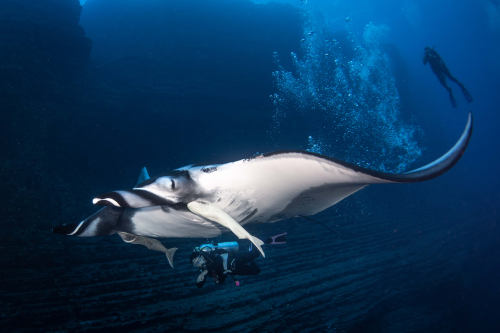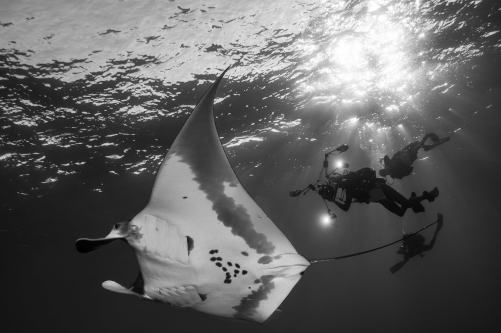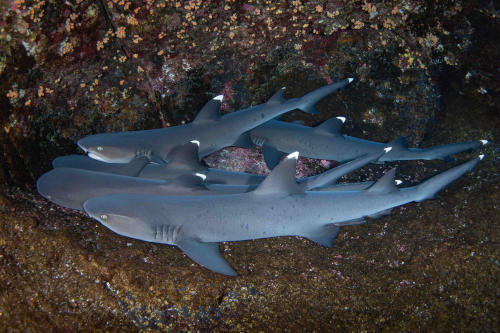Photographing the World’s Friendliest Mantas
Article by Brandi Mueller ( www.brandiunderwater.com )
As far as amazing underwater encounters go, diving with manta rays is one of the best. These spaceship-looking animals can look almost scary at first glance with their wingspans averaging eight to twelve feet (some documented to be over thirty feet), but as they glide smoothly over the top of a diver exhaling bubbles, it’s easy to see they are really beautiful, gentle creatures.

In spite of their massive size, mantas eat plankton, the itty bitty animals we hardly even notice in the water. They use cephalic fins, paddle-like appendages on both sides of their mouth, to funnel in water (and food). Often when they do this they swim in giant loops through the water column, like beautiful acrobatic dancers dressed in black and white.
With mostly black back, the undersides of mantas are a pattern of black and white unique and individual to each animal like a fingerprint. There are two types of mantas, black mantas which are mostly black with only a little white on their bellies and chevron mantas which have two white marks on their top side and much more white on their bellies. Images of the manta’s ventral sides have been used to identify and track mantas.
While mantas live in many of our favorite diving locations, including tropical to subtropical waters, we usually only see them if we get really lucky. But around the Revillagigedo Archipelago (known as the Socorro Islands) offshore of Baja, Mexico, divers are almost guaranteed manta sightings, and not just fleeting fly-bys. Known as the world’s friendliest mantas, those residing around Socorro seem to willingly interact with divers, spending entire dives just swimming from diver to diver, making eye contact, and checking the humans out.
The area also has cleaning stations where the mantas get a bit of a spa treatment. Clarion angelfish, cleaner wrasse, and other fish come in to clean the parasites and dead skin off the mantas. This symbiotic relationship helps both parties: the manta gets a good bath and the fish get dinner. For some reason these mantas also seem to enjoy the bubbles divers give off, perhaps it feels like a massage or tickles a bit? The mantas seem to swim right into the bubbles overtop a diver.

Tips for Photographing Mantas
· Just Breath – The mantas seem to like the massage-like feeling of diver’s exhaled bubbles and they will come around and swim right over top of divers. I almost felt like some manta even seem to take turns with us, visiting each of us, so we all got to see them (maybe they were seeing whose bubbles were best.) So just by exhaling, you can get up-close and personal to take images of these beautiful animals.
· Don’t Chase – Like any animals, if something seems to be chasing them, they run (or swim) away. Just stay in one spot and wait for the mantas to come to you. Sometimes strong swimming divers can even chase a manta off and it won’t come back for the rest of the dive.
· Go Fisheye – The mantas are big and they get close. Use your widest, wide-angle lens. Nothing is worse than cutting off a wingtip in an image because the manta was too big and too close to you! For compact camera users, invest in a wet-mount wide-angle lens.
· Get Settings Ready – The mantas will usually make a similar pattern over divers again and again. Do a few test shots if you can and have your settings and strobes ready to catch the moment you want. And if you missed it, set it up again and usually you just have to wait a little bit before the manta comes back and swims over again.
· Shoot in Different Directions – I like to stay at the edge of the dive group so that I can shoot into the crowd and get images with divers and then also turn a bit and get shots with the mantas but without divers in the shot. It’s nice to have a variety.
· Look behind you – Often the mantas are coming into the cleaning station area from the blue and you won’t see them until they’ve passed over you. Always keep an eye out all around.
· Get Creative – Diving with the Socorro mantas is a rare opportunity where you can expect to have a lot of time and chances to take photos of your subject. Once you have a ton of shots making images in the style you usually do, try something different. Play with your camera settings, adjust your strobe positioning (even turn them off and take some ambient light photos) and strength, take some video. You may not like all the images that come out, but you may get some amazing shots!
Diving Socorro is not just about mantas either! Divers are likely to see sharks of many species including piles of white tips, hammerheads, silvertips, Galapagos, and while it’s not actually a shark, some lucky visitors may see a whale shark or two. Almost as friendly as the mantas are the dolphins and the islands themselves make for great images too! Socorro should be on every manta-lover and diver’s bucket list. It will not disappoint!

These photos are from a trip Brandi took on the Nautilus Belle Amie to the Socorro Islands December 5-12, 2020. You can book thrips with Liquid Diving Adventures to the Socorro Islands as well as many other amazing destinations worldwide.